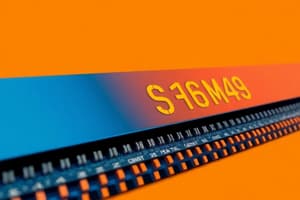Podcast
Questions and Answers
What is the primary benefit of having an on-chip cache in a processor?
What is the primary benefit of having an on-chip cache in a processor?
- It simplifies the overall system design
- It increases the size of the processor
- It eliminates the need for any external bus activity
- It reduces external bus activity and speeds up execution time (correct)
Which level of cache is designated as level 1 (L1)?
Which level of cache is designated as level 1 (L1)?
- The cache located off the processor chip
- The internal cache located on the processor chip (correct)
- The external cache that connects directly to the main memory
- The secondary cache that stores large blocks of data
How does the use of multilevel caches affect cache design issues?
How does the use of multilevel caches affect cache design issues?
- It abolishes the need for replacement algorithms
- It complicates various design issues such as size and write policy (correct)
- It limits the potential hit rates of caches
- It makes design issues simpler and more straightforward
What factor influences the potential savings from an L2 cache?
What factor influences the potential savings from an L2 cache?
In cache design, what does having a higher hit ratio indicate?
In cache design, what does having a higher hit ratio indicate?
What does virtual memory allow programs to do?
What does virtual memory allow programs to do?
What component translates virtual addresses into physical addresses?
What component translates virtual addresses into physical addresses?
Which of the following statements is true about logical addresses?
Which of the following statements is true about logical addresses?
What is the primary role of the MMU in the context of virtual memory?
What is the primary role of the MMU in the context of virtual memory?
Which of the following best describes the relationship between cache memory and virtual memory?
Which of the following best describes the relationship between cache memory and virtual memory?
What happens when both CD and NW control bits are set to 1?
What happens when both CD and NW control bits are set to 1?
Which combination of control bits results in all modes being enabled?
Which combination of control bits results in all modes being enabled?
When CD is set to 1 and NW is set to 0, which operation is disabled?
When CD is set to 1 and NW is set to 0, which operation is disabled?
Which operating mode combination is deemed invalid?
Which operating mode combination is deemed invalid?
In the mode where CD = 1 and NW = 1, what is the status of write-throughs?
In the mode where CD = 1 and NW = 1, what is the status of write-throughs?
What is the primary characteristic that defines volatile memory?
What is the primary characteristic that defines volatile memory?
Which of the following best describes access time in the context of memory performance?
Which of the following best describes access time in the context of memory performance?
What type of memory is characterized by the fact that information cannot be altered without destroying the storage unit?
What type of memory is characterized by the fact that information cannot be altered without destroying the storage unit?
Which parameter indicates how quickly data can be transferred into or out of a memory unit?
Which parameter indicates how quickly data can be transferred into or out of a memory unit?
In the context of random-access memory, what does organization refer to?
In the context of random-access memory, what does organization refer to?
Which of the following is NOT a common form of memory?
Which of the following is NOT a common form of memory?
What is the relationship between cycle time and transfer rate in random-access memory?
What is the relationship between cycle time and transfer rate in random-access memory?
Which description fits nonvolatile memory?
Which description fits nonvolatile memory?
Which processor was introduced in 1985 and has an L1 cache of 128 to 256 kB?
Which processor was introduced in 1985 and has an L1 cache of 128 to 256 kB?
What is the L2 cache size of the Itanium 2 processor?
What is the L2 cache size of the Itanium 2 processor?
Which processor introduced in 1993 has an L3 cache of 2 MB?
Which processor introduced in 1993 has an L3 cache of 2 MB?
Which mainframe processor has the largest L3 cache size based on the provided data?
Which mainframe processor has the largest L3 cache size based on the provided data?
How much L1 cache does the Intel 80486 processor have?
How much L1 cache does the Intel 80486 processor have?
Which processor introduced in 2000 has no L3 cache listed?
Which processor introduced in 2000 has no L3 cache listed?
What is the L2 cache size of the PDP-11/70?
What is the L2 cache size of the PDP-11/70?
Which of the following processors was introduced earliest?
Which of the following processors was introduced earliest?
What is the L1 cache configuration for the POWER6 processor?
What is the L1 cache configuration for the POWER6 processor?
Which processor from the data has the smallest L1 cache size?
Which processor from the data has the smallest L1 cache size?
Flashcards are hidden until you start studying
Study Notes
Capacity and Performance of Memory
- Memory cycle time, access time (latency), and transfer rate are crucial performance parameters.
- Access time for random-access memory (RAM) includes the duration for read/write operations.
- Non-random-access memory requires additional time for positioning the read-write mechanism and handling signal transients.
- Transfer rate reflects the speed of data transfer into and out of memory, typically defined as 1/(cycle time) for RAM.
Types of Memory
- Common forms include semiconductor, magnetic surface, optical, and magneto-optical memory.
- Volatile memory loses information when power is turned off, while nonvolatile memory retains data without needing power.
- Magnetic-surface memory is inherently nonvolatile, whereas semiconductor memory can be either volatile or nonvolatile.
- Nonerasable memory, such as read-only memory (ROM), cannot be altered without physically destroying the unit.
Memory Organization
- In RAM, organization pertains to the arrangement of bits into words, influencing performance and efficiency.
Virtual Memory
- A virtual memory system allows programs to use logical addresses independent of physical memory availability.
- Virtual addresses in machine instructions require a memory management unit (MMU) to convert them into physical addresses in main memory.
Cache Memory and Types
- Cache memory is essential for speeding up data access and reducing bus activity, which improves system performance.
- Modern processors can integrate cache directly onto the chip, providing faster access to instructions and data.
Multilevel Caches
- Cache hierarchy often includes level 1 (L1) as internal cache and level 2 (L2) as external cache.
- The effectiveness of multilevel caches depends on hit rates in both L1 and L2, impacting overall performance and design complexity.
- Design considerations for caches encompass size, replacement algorithms, and write policies.
Processor Cache Examples
- Early processors introduce varying cache sizes, e.g., IBM's 360/85 with 16-32 kB L1 cache (1968) and later models like the Pentium 4 with L1 cache of 8 kB.
Cache Performance Metrics
- A graph illustrating total hit ratio shows higher efficiency with larger L2 cache sizes and optimal L1 configurations.
- Cache operating modes can be configured to enable/disable cache fills and write-through mechanisms, impacting data handling efficiency.
Summary of Cache Design Elements
- Key cache design elements include characteristics of memory systems, cache size, mapping functions, replacement algorithms, and write policies.
- Understanding cache organization, control bits, and operational modes is critical for optimizing memory performance.
Studying That Suits You
Use AI to generate personalized quizzes and flashcards to suit your learning preferences.




